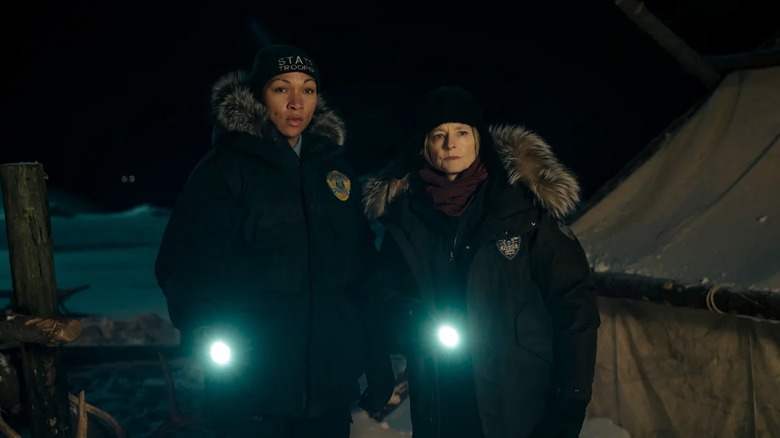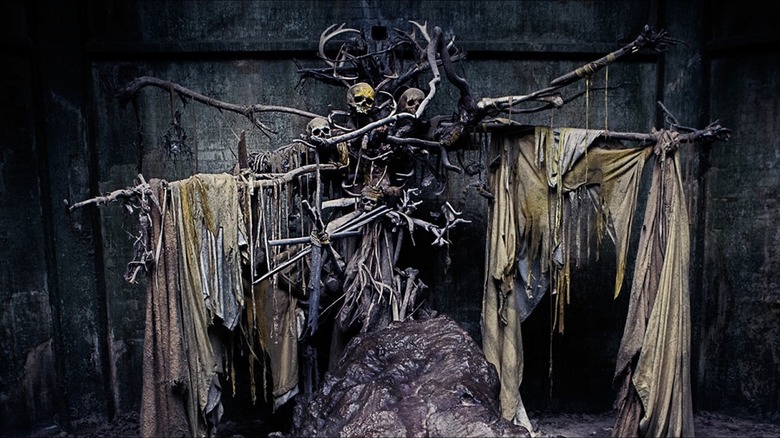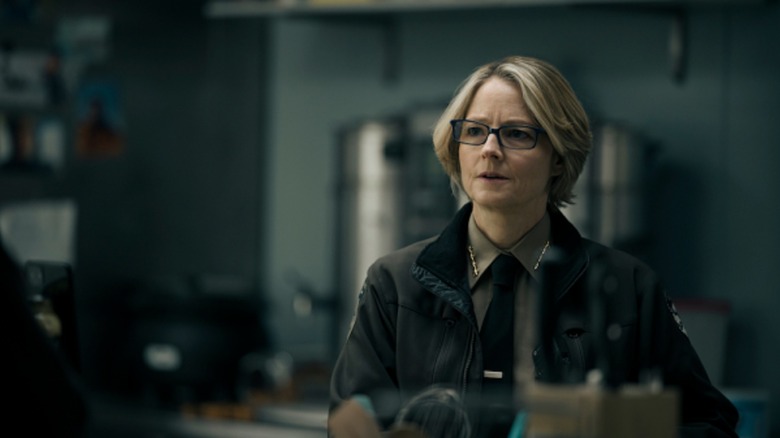True Detective: Night Country Wears Its Horror Inspirations On Its Sleeve
This post contains spoilers for the first episode of "True Detective: Night Country."
It has been 10 years since the first season of "True Detective" aired on HBO, kickstarting an unforgettable legacy that still endures. The case at the center of this first season was mired in dark secrets and a unique brand of esoterism, coupled with the horrors of cosmic entities that may or may not have been lurking within the ruins of Carcosa. While the transgressions of the Tuttle cult were unspeakably evil, highlighting the worst that humans are capable of, there is an unmistakeable otherworldly aura to the first season, be it in the form of aerial spirals or visions that told a darker truth. "True Detective: Night Country," the fourth and latest season in the franchise, continues the tradition of dissecting a case that seems grounded in practicality but delves into the ominous supernatural in ways that call back to the original.
"Night Country" offers a premise that evolves into its own character in the first episode itself, namely the fictional mining town of Ennis, situated in the snowy vistas of Alaska. The unforgivable cold and the perpetual darkness add to the moody, intense crime procedural, where a group of researchers go missing from their arctic research base — an event that seems to be tied to an unresolved murder case from years ago. While "Night Country" reinvents its "True Detective" brand with a story that feels deliciously gritty and character-driven from the get-go, it also wears its cosmic horror inspirations on its sleeve, with obvious tie-ins with the esoteric themes that run through the labyrinth of season 1's mystery.
Night Country calls back to True Detective's Yellow King
The new season opens with the quote: "For we do not know what beasts the night dreams when its hours grow too long for even God to be awake." While this quote does not belong to any existing literary work and acts as a prologue to the perpetual darkness that envelops the dark secrets that fester in Ennis, it is attributed to someone named Hildred Castaigne. Castaigne doesn't exist, as he is the protagonist of the short story, "The Repairer of Reputations" from Robert W. Chambers' 1895 weird fiction collection, "The King in Yellow." Yes, Chambers' book sounds familiar, as it is the direct basis for season 1's Yellow King, whose identity is still shrouded in mysterious symbolism and remains one of the most compelling aspects of the original's season finale to date.
This begs the question, how does "The Repairer of Reputations" tie symbolically to "Night Country"? Castaigne's defining characteristic is his unhinged obsession with the fictional play, "The King in Yellow," which drives readers to the point of madness within the story, and appears in several shorts in Chambers' 1895 anthology. The connection here is not Castaigne himself, but the opening of "Repairer of Reputations," which quotes excerpts from the maligned play, and describes the otherworldly city of Carcosa, with its twin sunken suns and black stars that submerge the space in strange shadows.
Carcosa was the ruins in the bayou where the Tuttles engaged in sadistic ritual abuse of children, and Rust Cohle (Matthew McConaughey) encountered a cosmic vortex there while noticing a shrine to the Yellow King. However, in "Night Country," Ennis is likened to Carcosa in Chambers' work, where its bleak strangeness isolates itself from the world, as it emits an eerily supernatural sheen.
True Detective's newest season revels in its horror inspirations
The Yellow King, also known as Hastur, is not Chambers' creation, as this entity first appeared in Ambrose Bierce's "Haïta the Shepherd" and was later used by other weird fiction authors, including H.P. Lovecraft and August Derleth. While it is too early to parse whether "Night Country" will fully lean into cosmic horror, the series is undoubtedly shrouded in supernatural shadows that often reference tropes within the genre in the form of omens. For instance, the episode opens with a herd of Caribous jumping off the ice after the last sunset of the year, echoing the widespread myth of lemmings committing mass suicide meant to signal an oncoming bad omen or reveal the intricacies of human herd mentalities.
There is something amiss in Ennis, a town that has to undergo months of endless nights amid a mysterious disappearance and the eventual discovery of bodies in the ice. The frozen researchers look like a mangled mass of bodies, their faces contorted in horror as if they witnessed something too terrifying for human comprehension before their deaths. The discovery in itself is surreal, as a dead man howls in the night and points toward the buried men, which seems to only be a prelude to the presence of something inhuman in the ice. There are glimpses of dream logic, such as when Evangeline Navarro (Kali Reis) sees a one-eyed polar bear on the road, but the actual implications of this vision remain to be unraveled.
Whether these visions are real or not, "Night Country" establishes the unnatural nature of its location, and how it directly molds the people inhabiting it, whether they realize it or not.
The first episode of "True Detective: Night Country" premiered on January 14, 2024, on HBO.


